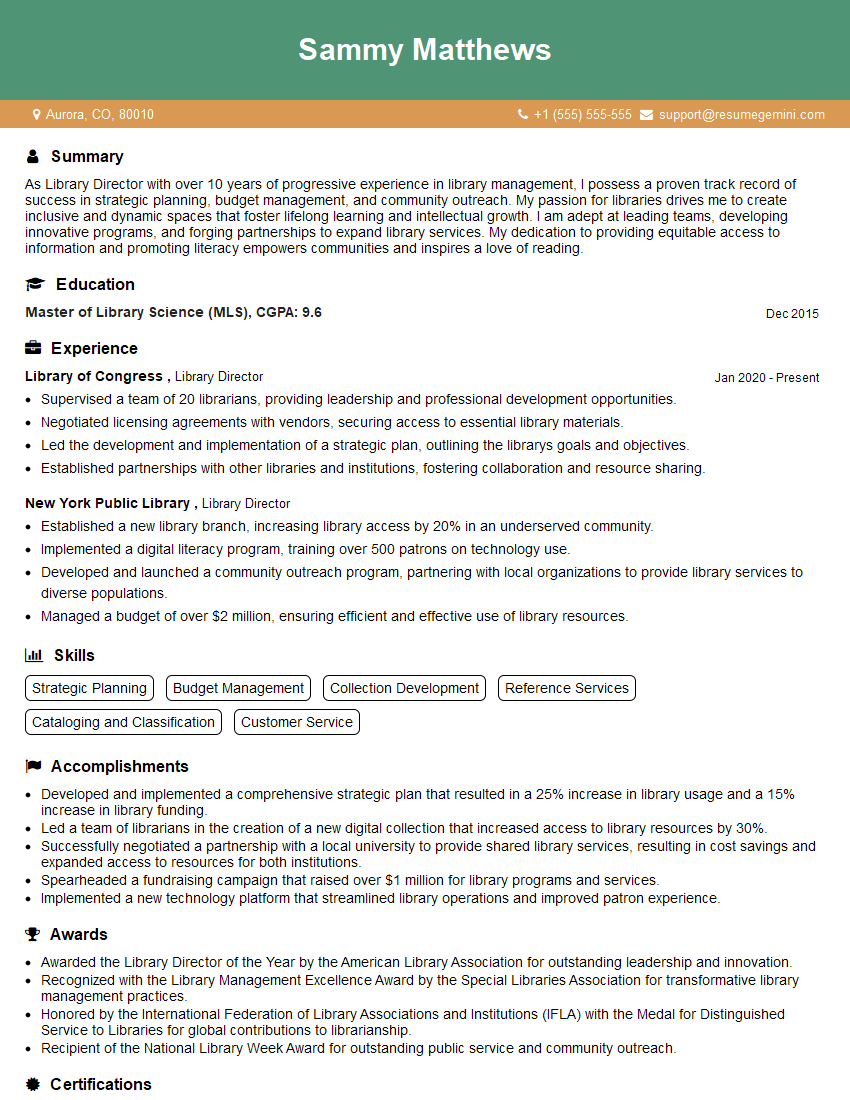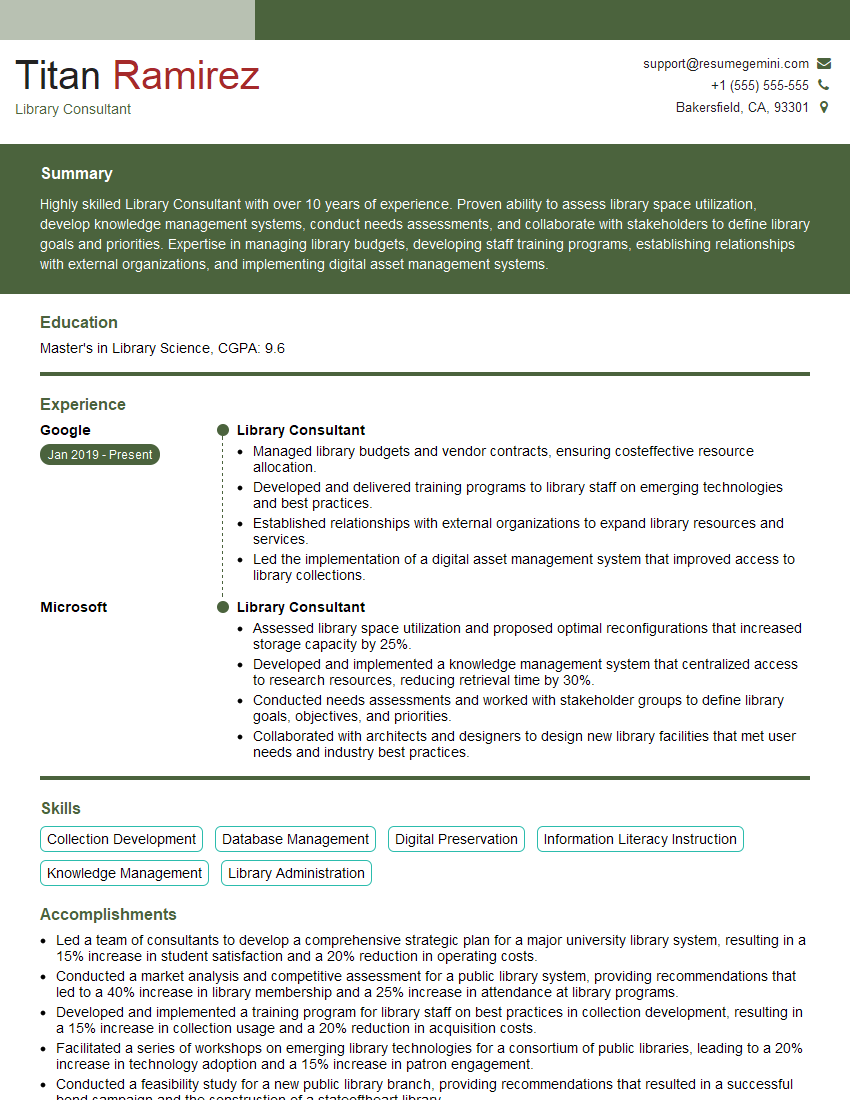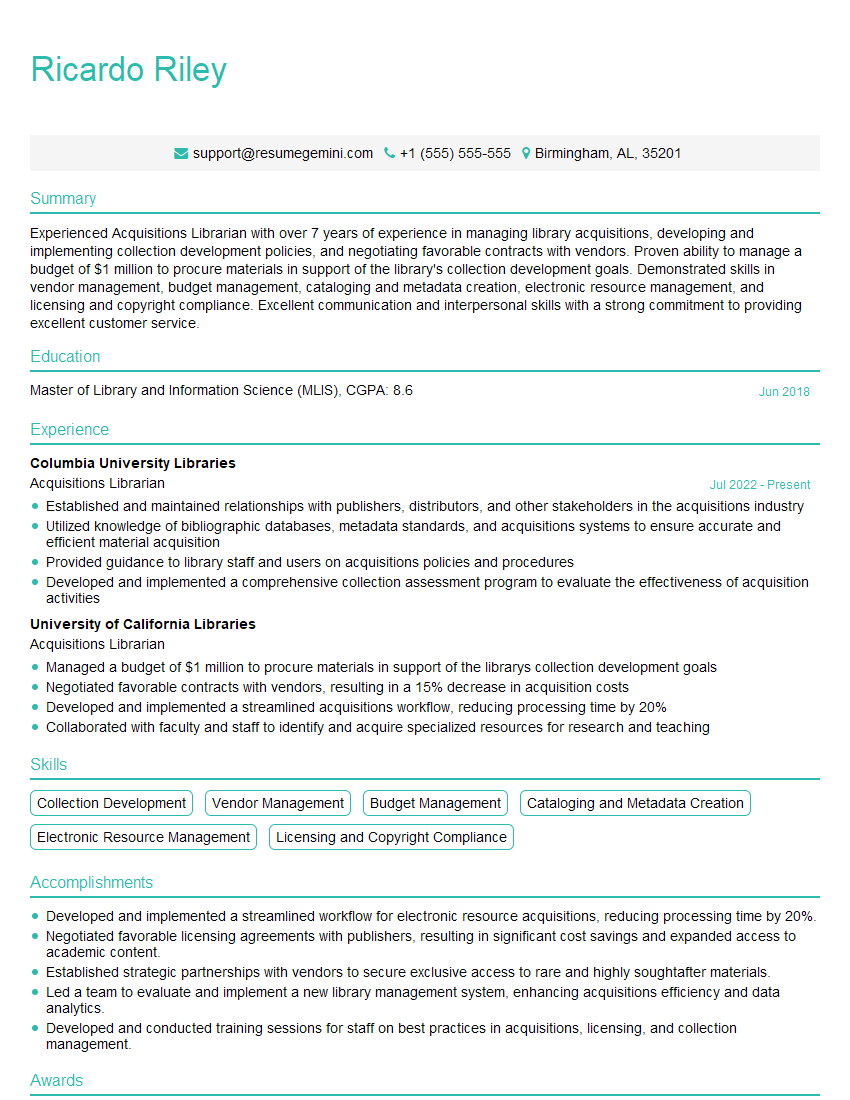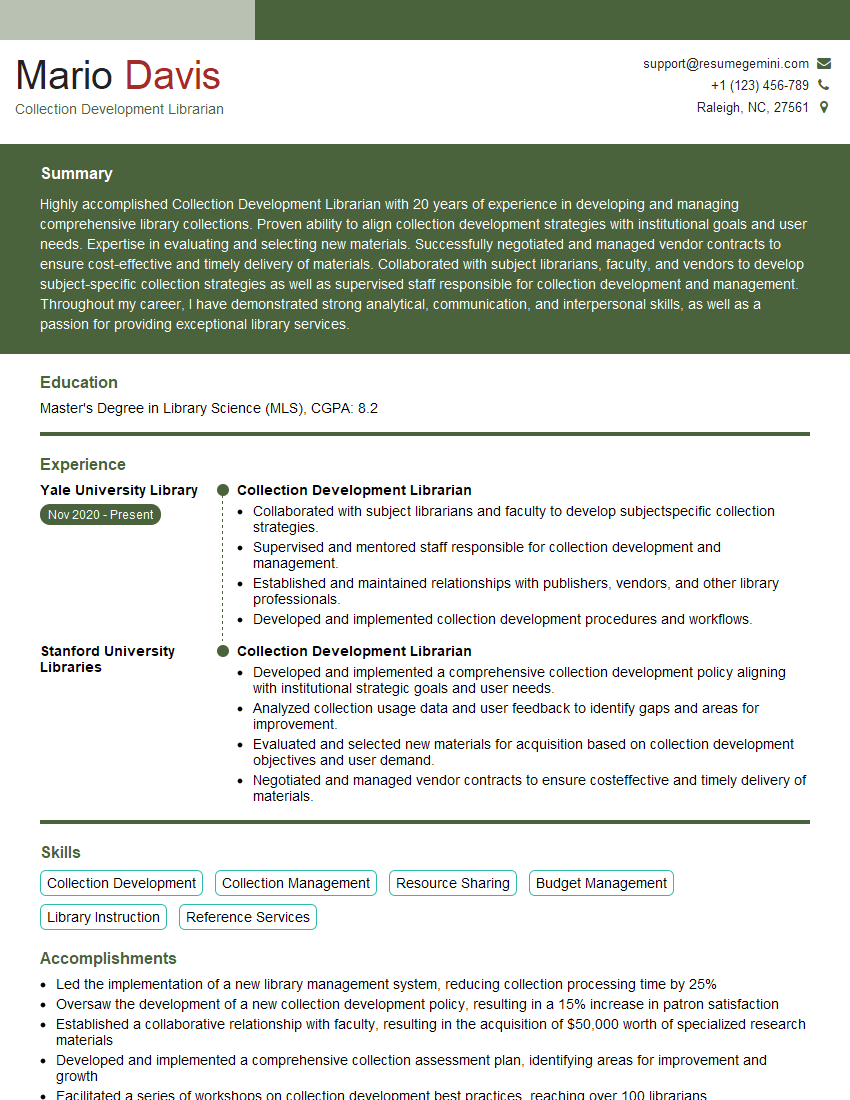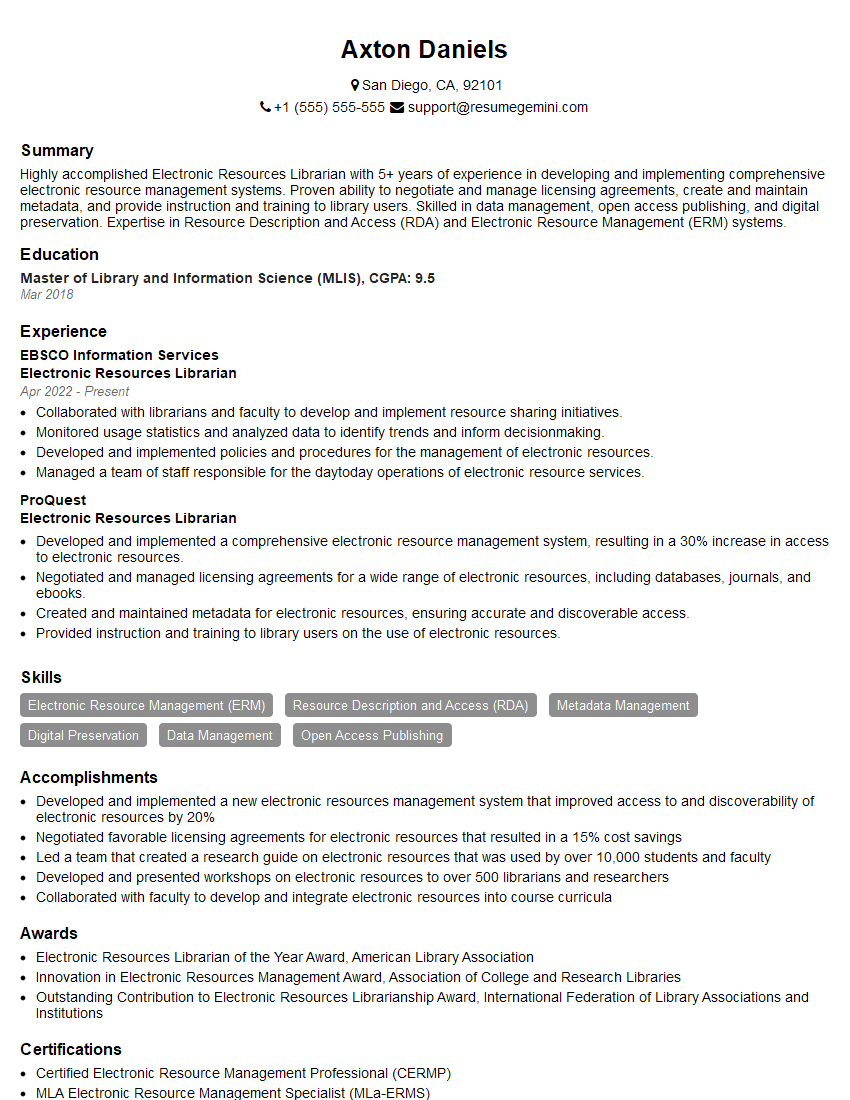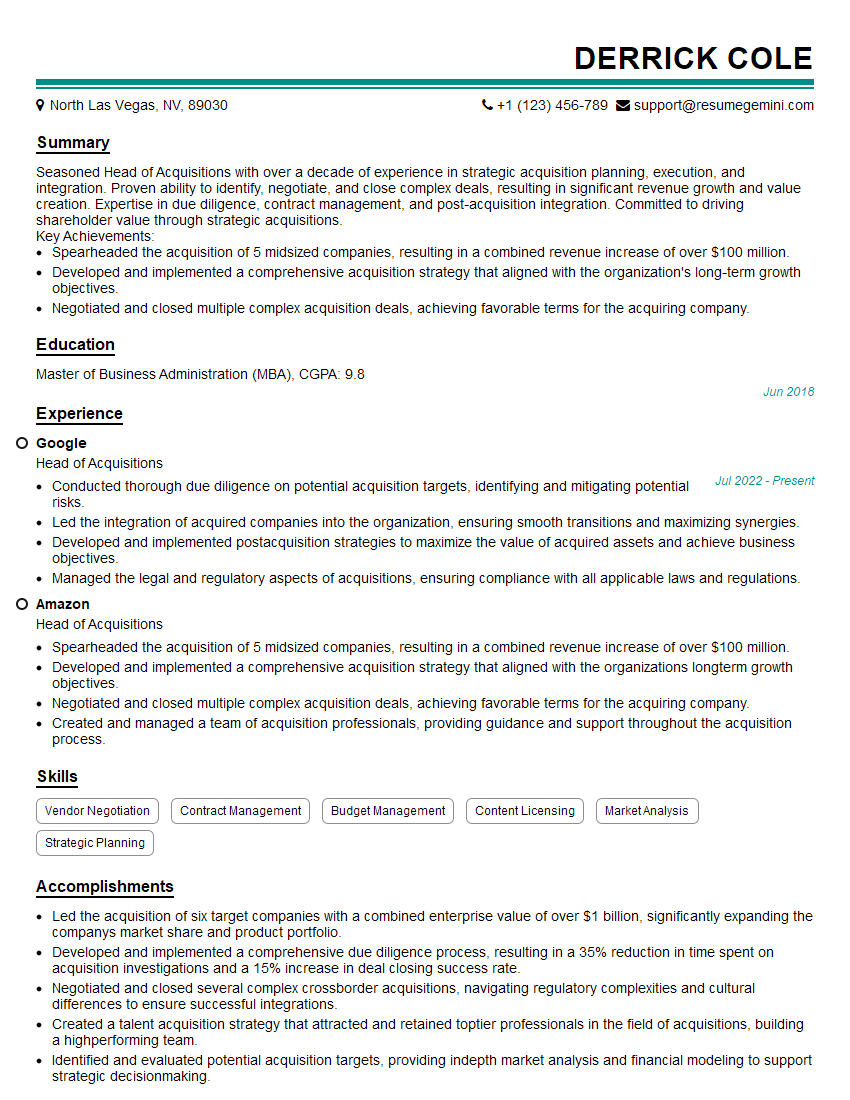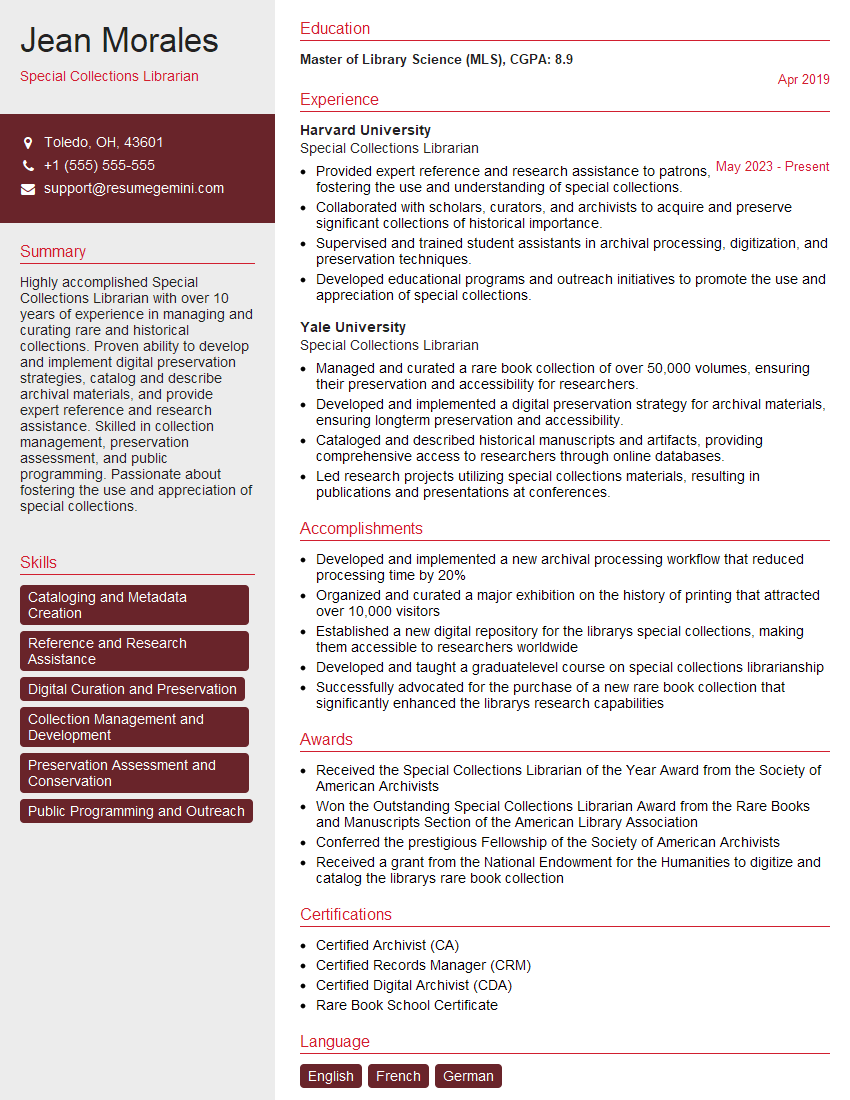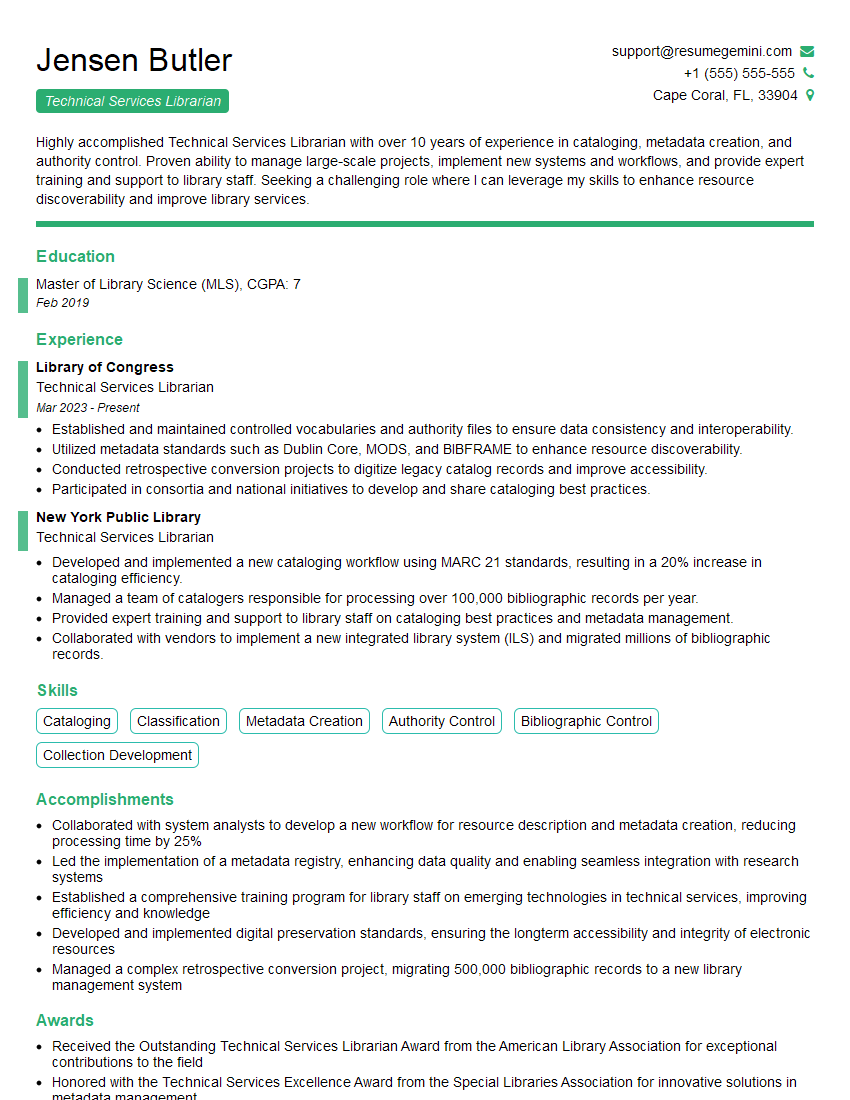Feeling uncertain about what to expect in your upcoming interview? We’ve got you covered! This blog highlights the most important Ability to stay up-to-date with current trends in library acquisitions interview questions and provides actionable advice to help you stand out as the ideal candidate. Let’s pave the way for your success.
Questions Asked in Ability to stay up-to-date with current trends in library acquisitions Interview
Q 1. What are the current trends in ebook acquisitions?
Current ebook acquisition trends are dynamic, shaped by technology and user expectations. We’re seeing a shift away from perpetual access models towards subscription-based services like OverDrive and EBSCOhost, offering cost predictability but potentially limiting long-term access. Another trend is the rise of patron-driven acquisition (PDA), where libraries purchase ebooks based on user demand, optimizing budgets and ensuring relevance. Simultaneously, there’s a growing emphasis on accessibility features, with libraries increasingly prioritizing ebooks with robust accessibility options for visually impaired or other users with disabilities. The move towards open access ebooks is another noteworthy factor, although still developing. Finally, the integration of ebook platforms with library management systems (LMS) is constantly improving, streamlining acquisitions and management processes.
For example, one library I worked with successfully implemented a PDA system, leading to a 20% increase in ebook circulation within a year by focusing on titles that their patrons actively requested. Another example is our transition to a subscription model for a major ebook provider, which, despite initial concerns, proved financially sounder and allowed us to offer a much broader collection than before.
Q 2. How do you stay updated on changes in copyright law affecting library acquisitions?
Staying current on copyright law is crucial for responsible library acquisitions. I utilize several methods to ensure compliance. I subscribe to journals like the Copyright Law Reporter, attend conferences organized by organizations like the American Library Association (ALA) and the International Federation of Library Associations and Institutions (IFLA), and closely monitor updates from the U.S. Copyright Office and similar bodies in other relevant jurisdictions. I also rely on reputable legal resources like the Copyright Clearance Center (CCC) for guidance on permissions and licensing issues. Furthermore, I participate in professional development webinars and workshops focused on copyright and intellectual property in libraries. This multifaceted approach helps me stay informed about legislative changes and best practices. This preventative approach is far better than reactive measures, and has saved the libraries I’ve worked for from potential legal challenges.
Q 3. Describe your experience with open access publishing and its impact on library acquisitions.
Open access publishing has significantly impacted library acquisitions. It offers a promising path towards greater affordability and accessibility of scholarly works. Previously, libraries had to pay substantial sums for subscriptions and individual purchases. Open access resources often eliminate these costs, saving the library budget for other materials and services. However, there are caveats. While many open access journals are high quality, quality control mechanisms can vary. Ensuring that open access articles meet the library’s standards of quality and scholarly rigor is a continuing challenge. Also, there’s the issue of metadata and discoverability; seamlessly integrating open access resources into the library’s catalog and discovery systems is an important consideration. I’ve directly experienced the benefits by reducing our journal subscription costs by approximately 15% through increased reliance on open-access resources, while simultaneously enriching our collection with many more scholarly papers.
Q 4. What are some current challenges in managing subscription costs for journals and databases?
Managing subscription costs for journals and databases is an ongoing challenge for libraries. Factors include rising subscription prices, the pressure to offer access to a broad range of high-quality materials, and budgetary constraints. Strategies for managing costs include consortial purchasing (joining with other libraries to negotiate better prices), adopting a more selective approach to journal subscriptions (canceling less-used titles), and exploring alternative access models such as open access and institutional repositories. Negotiating directly with publishers is another critical strategy. Understanding the usage statistics of our databases and journals provides valuable data that strengthens our negotiating positions. For instance, I once successfully negotiated a 10% discount on a major database subscription by presenting detailed usage data demonstrating consistent high utilization among our researchers.
Q 5. How do you evaluate the cost-effectiveness of different acquisition methods?
Evaluating the cost-effectiveness of different acquisition methods requires a multifaceted approach. I utilize a combination of quantitative and qualitative measures. Quantitative factors include the cost per item, usage statistics (circulation numbers, downloads, etc.), and the overall budget impact. Qualitative factors include accessibility of materials, the quality of content, the reputation of the publisher or vendor, and the long-term implications of different acquisition models (e.g., perpetual access versus subscription). A cost-benefit analysis, comparing the costs against anticipated use and overall value, is key to determining the best option. For example, if a heavily used journal has high renewal costs, we might explore alternative avenues, such as negotiating a lower rate or opting for an open access equivalent.
Q 6. What strategies do you employ to identify and acquire emerging scholarly resources?
Identifying and acquiring emerging scholarly resources requires proactive strategies. I actively monitor relevant journals, attend conferences and workshops, and regularly review publisher catalogs and announcements. I also actively engage with faculty and researchers to understand their needs and stay abreast of new developments in their fields. I utilize subject-specific databases and indices, and actively search for preprints and early releases. Following key researchers and institutions on social media and other online platforms can provide alerts on new publications and projects. I’ve built strong relationships with publishers’ representatives, who keep me updated on their forthcoming releases. This diverse approach allows me to anticipate future trends and acquire valuable materials before they become widely available.
Q 7. Explain your experience using various library management systems for acquisitions.
I have extensive experience with various library management systems (LMS) for acquisitions, including integrated systems like Alma (Ex Libris), Koha, and Innovative Interfaces’ Sierra. My experience encompasses using these systems for everything from initial ordering and budgeting to tracking invoices, managing vendor communication, and generating reports. I’m familiar with both the technical aspects of data entry and workflows and the strategic implications of using these systems effectively to optimize acquisition processes. For instance, I’ve configured custom workflows in Alma to automate certain tasks, such as generating purchase orders and tracking acquisitions through the various stages of the process, resulting in a significant reduction in processing time and human error. The ability to customize and tailor workflows in an LMS is incredibly important to making these systems work efficiently.
Q 8. How do you assess the quality and relevance of potential acquisitions?
Assessing the quality and relevance of potential acquisitions is a multifaceted process that goes beyond simply looking at the title or abstract. It involves a critical evaluation using several key criteria.
- Content Analysis: I carefully examine reviews, table of contents, indexes, and sample chapters (if available) to gauge the accuracy, depth, and originality of the content. Is the information current and relevant to our user base? Does it offer a unique perspective or fill a gap in our collection? For example, if we’re considering a textbook, I would compare it to existing resources, looking for updated research, improved pedagogical approaches, or a different theoretical framework.
- Authoritative Sources: I verify the author’s expertise and reputation. Are they recognized leaders in their field? Have their previous works been well-received? Checking the publisher’s reputation is also crucial; reputable publishers often have rigorous quality control processes.
- User Needs and Alignment with Collection Development Policy: This is paramount. Every acquisition must align with our library’s collection development policy, which details the types of materials we acquire and the user needs we aim to meet. I regularly consult usage statistics, feedback from faculty and students, and curriculum mapping to ensure acquisitions directly support teaching, learning, and research activities.
- Format and Accessibility: I consider the format (print, ebook, database, etc.) and its accessibility for users with disabilities. We must prioritize inclusivity and ensure all materials are usable by our diverse community. This includes considering factors like screen reader compatibility and alternative text for images.
By employing a systematic approach incorporating these elements, I can confidently assess the value and relevance of any potential acquisition, ensuring it aligns with our library’s mission and the needs of our users.
Q 9. Discuss the role of data analytics in informing library acquisitions decisions.
Data analytics plays a transformative role in modern library acquisitions. It moves us beyond guesswork and enables data-driven decision-making. Instead of relying solely on intuition, we leverage data to understand usage patterns, predict future needs, and optimize resource allocation.
- Usage Statistics: Circulation data, database access logs, and ebook download statistics reveal which resources are most popular and which are underutilized. This informs decisions about renewing subscriptions, purchasing additional copies of high-demand materials, or weeding out underperforming items.
- Collection Analysis: Analyzing our holdings allows us to identify gaps in coverage, subject areas needing strengthening, or areas where we have excessive duplication. We might use tools to map our collection against subject classification systems or compare our holdings to those of peer institutions.
- Predictive Analytics: Advanced analytics can predict future demand based on historical trends and emerging research areas. This allows proactive acquisitions, ensuring we have materials available when users need them, rather than reactively responding to demand.
- Cost-Benefit Analysis: Data helps us compare the cost of different resources against their usage and value. We can evaluate whether the price of a subscription is justified by the number of users accessing it, for example.
In practice, this might involve using library management systems (like Koha or Alma) that generate usage reports, integrating with analytical tools to visualize data, and building dashboards to monitor key performance indicators (KPIs).
Q 10. How do you collaborate with faculty and other stakeholders to identify acquisition needs?
Collaboration is essential for effective acquisitions. It ensures our collection meets the needs of the entire academic community. I actively engage with faculty, students, and other stakeholders through various methods.
- Faculty Liaison Program: I work closely with faculty liaisons who represent different departments and disciplines. Regular meetings help identify research needs, teaching requirements, and emerging trends in their fields. This ensures our collection supports current and future curriculum requirements.
- Surveys and Focus Groups: Gathering feedback directly from users via surveys and focus groups provides valuable insights into their information needs and preferences. This helps assess user satisfaction and identify areas for improvement in our collection.
- Curriculum Mapping: By carefully examining course syllabi, I can pinpoint specific texts and resources required for classes, helping me prioritize acquisitions that directly support teaching.
- Departmental Meetings and Presentations: I regularly attend departmental meetings and give presentations to keep faculty informed about our acquisition plans and solicit feedback. This promotes transparency and ensures our decisions are well-informed.
- Suggestion Boxes and Online Feedback Mechanisms: I make it easy for users to suggest new acquisitions, providing multiple channels for them to communicate their needs.
This multi-faceted approach ensures a collaborative and responsive acquisitions process that reflects the priorities of our entire community.
Q 11. What are the ethical considerations involved in library acquisitions?
Ethical considerations are paramount in library acquisitions. We must balance the needs of our users with our responsibilities to ensure fairness, transparency, and intellectual property rights.
- Copyright Compliance: We must adhere strictly to copyright laws when acquiring and using materials. This includes understanding fair use principles and obtaining necessary permissions for reproduction or distribution.
- Open Access and Resource Accessibility: We strive to acquire and promote open access resources to ensure equitable access to information for all users. This means considering the cost, licensing restrictions, and accessibility features of materials before acquisition.
- Diversity and Inclusion: We actively seek to build a diverse and inclusive collection that represents a wide range of voices, perspectives, and experiences. This involves actively selecting materials that challenge biases and address diverse needs.
- Vendor Selection: We must select vendors that adhere to ethical business practices. This includes considering their labor practices, environmental sustainability initiatives, and commitment to fair pricing.
- Transparency and Accountability: We maintain transparency in our acquisition decisions, documenting our selection criteria and processes. This promotes accountability and ensures that our actions are justifiable and align with our mission.
Ethical considerations are integrated into every step of the acquisitions process, from initial selection to ongoing management. We regularly review our practices to ensure they align with best practices and ethical guidelines.
Q 12. Describe your experience with vendor selection and negotiation.
Vendor selection and negotiation are crucial for securing the best resources at the most favorable prices. My approach involves a thorough and systematic process.
- Vendor Research: I research potential vendors based on their reputation, pricing, services, and technological capabilities. I examine customer reviews, compare offerings, and consider their track record of delivering high-quality materials on time.
- Request for Proposals (RFPs): For significant purchases, I develop and issue RFPs to solicit bids from multiple vendors. This ensures competitive pricing and allows for careful comparison of services.
- Negotiation: I engage in effective negotiation with vendors, aiming to secure the best possible terms, including discounts, expedited shipping, and flexible payment options. This requires a strong understanding of market prices and the ability to articulate our needs and priorities.
- Contract Review: Before finalizing any agreements, I meticulously review contracts to ensure they protect our interests and comply with all relevant laws and regulations. This includes paying close attention to licensing terms, access limitations, and renewal options.
- Vendor Relationship Management: I build and maintain strong relationships with vendors, fostering trust and collaboration. This can lead to better service, more favorable pricing, and faster resolution of any issues that may arise.
For example, when negotiating ebook subscriptions, I might leverage our library’s size and usage data to negotiate bulk discounts or extended access periods. Building strong relationships with vendors is critical in this process, often resulting in mutually beneficial outcomes.
Q 13. How do you manage acquisitions workflows to ensure efficiency?
Efficient acquisitions workflows are crucial for timely delivery of resources and minimizing administrative burden. I utilize a combination of technologies and processes to optimize workflows.
- Integrated Library System (ILS): Our ILS serves as the central hub for managing acquisitions, from order placement to cataloging and receiving. It streamlines the entire process, reducing manual data entry and improving accuracy.
- Workflow Automation: I utilize automated processes whenever possible, such as automated ordering systems, electronic invoicing, and automated fund accounting. This frees up time for higher-level tasks such as collection development and user engagement.
- Standard Operating Procedures (SOPs): Clear and well-defined SOPs guide every stage of the acquisition process, ensuring consistency and efficiency. This reduces errors, speeds up processing, and facilitates training of new staff members.
- Regular Monitoring and Evaluation: I regularly monitor key metrics such as order turnaround times, processing delays, and vendor performance. This identifies bottlenecks and areas for improvement in our workflows.
- Collaboration and Communication: Effective communication between the acquisitions team, cataloging staff, and other library departments is vital for seamless workflow. Regular meetings and clear communication channels help to keep everyone informed and minimize delays.
By implementing these strategies, I ensure that our acquisitions process is efficient, accurate, and responsive to the needs of our users.
Q 14. What are your strategies for dealing with budget constraints in library acquisitions?
Budget constraints are a common challenge in library acquisitions. My strategies for managing them focus on maximizing value and prioritizing needs.
- Prioritization Based on User Needs and Collection Gaps: I prioritize acquisitions that directly support the needs of our users and fill gaps in our collection. This ensures that limited funds are used effectively to support teaching, learning, and research.
- Exploring Alternative Acquisition Models: I explore alternative acquisition models such as open access resources, consortial purchasing, and resource sharing agreements. These can significantly reduce costs and provide access to a wider range of materials.
- Strategic Budgeting and Resource Allocation: I develop a well-defined budget that aligns with our strategic goals and prioritizes high-impact acquisitions. This may involve reallocating funds from underutilized areas to support more critical needs.
- Negotiating with Vendors: As mentioned earlier, negotiating with vendors for favorable pricing and payment terms can significantly impact budget management. This requires a thorough understanding of market prices and the ability to effectively advocate for our needs.
- Data-Driven Decision-Making: By using usage data and analytics, I can make informed decisions about which resources offer the best value for their cost, ensuring that our limited budget is used as efficiently as possible.
- Developing a Collection Development Policy: A robust collection development policy can guide acquisitions decisions and help set realistic expectations for resource allocation, ensuring that our budget reflects our priorities and goals.
Effective budget management requires a combination of careful planning, strategic decision-making, and proactive exploration of alternative acquisition methods.
Q 15. How do you incorporate user feedback into your acquisitions decisions?
User feedback is paramount in shaping a library’s collection. I actively solicit feedback through various channels to ensure the collection aligns with patron needs. This includes:
- Surveys: Regular online and in-person surveys gauge satisfaction with existing resources and identify gaps.
- Focus Groups: Targeted discussions with specific user groups (e.g., students, researchers, community members) provide in-depth insights.
- Suggestion Boxes/Online Forms: Easy-to-use platforms encourage spontaneous feedback on desired materials.
- Patron Interviews: One-on-one conversations allow for personalized understanding of individual needs and preferences.
- Usage Statistics: Circulation data, database access logs, and website analytics offer objective measures of resource popularity and usage patterns. Low usage of specific resources flags potential areas for collection refinement.
For example, consistently low circulation of a particular genre of fiction might prompt a reevaluation of acquisitions in that area, perhaps diverting funds towards genres reflecting greater patron demand, as evidenced by usage statistics and feedback. This data-driven approach ensures resources are relevant and valuable to the library’s community.
Career Expert Tips:
- Ace those interviews! Prepare effectively by reviewing the Top 50 Most Common Interview Questions on ResumeGemini.
- Navigate your job search with confidence! Explore a wide range of Career Tips on ResumeGemini. Learn about common challenges and recommendations to overcome them.
- Craft the perfect resume! Master the Art of Resume Writing with ResumeGemini’s guide. Showcase your unique qualifications and achievements effectively.
- Don’t miss out on holiday savings! Build your dream resume with ResumeGemini’s ATS optimized templates.
Q 16. Explain your experience with consortial acquisitions.
Consortial acquisitions have been a cornerstone of my experience, offering significant cost savings and access to a wider range of resources. I’ve participated in consortia that leverage collective purchasing power to negotiate better prices with vendors and ensure wider availability of specialized materials. This collaborative model allows smaller libraries to access resources that might be beyond their individual budgets.
My experience includes:
- Negotiating contracts: Participating in collaborative negotiations to secure favorable terms for digital resources, including e-books, databases, and journals.
- Collection development planning: Working with other libraries to identify shared priorities and collectively develop acquisition plans, ensuring minimal duplication of effort and maximum resource utilization. For instance, one library might specialize in humanities while another focuses on STEM, fostering a balanced and comprehensive collection across the consortium.
- Resource sharing and management: Implementing and utilizing shared resource management systems to track acquisitions, simplify access, and ensure efficient resource allocation.
Through consortial participation, I’ve successfully secured access to premium databases and e-book collections unavailable to individual libraries. The shared governance model promotes efficient use of funds and fosters collaborative learning among library professionals.
Q 17. What are some innovative approaches to collection development you are aware of?
Innovative approaches to collection development are constantly emerging. Some notable examples include:
- Data-Driven Acquisitions: Utilizing predictive analytics and machine learning to forecast demand and optimize resource selection based on usage patterns and emerging trends. Tools analyze usage data to suggest potential acquisitions that align with patron interests.
- Open Access Resources: Actively seeking and promoting open access materials, reducing reliance on costly commercial resources while supporting the principle of scholarly communication. This promotes wider access and affordability.
- Crowdsourcing: Engaging users in the selection process through platforms that allow patrons to suggest purchases, thereby fostering a more community-driven approach to collection development.
- MakerSpaces and Digital Fabrication Resources: Integrating physical and digital resources to support creative learning and innovation, going beyond traditional library materials to provide hands-on learning opportunities.
- Community Archives and Local History Collections: Developing curated collections of locally relevant materials, preserving community history and cultural heritage, fostering local pride and engagement with the library.
For instance, incorporating a 3D printer and related software into the library’s collection expands opportunities for creative projects and learning, aligning with current trends in digital fabrication. This approach extends the library’s role beyond traditional resource provision.
Q 18. How do you balance access to resources with preservation considerations?
Balancing access with preservation is a crucial aspect of collection management. It requires a multifaceted approach:
- Digital Preservation Strategies: For digital resources, this includes regular backups, migrating data to new formats as technology evolves, and employing robust metadata management to ensure long-term accessibility.
- Preservation of Physical Materials: Proper environmental control (temperature, humidity), regular inspection and repair of damaged items, and digitization of fragile materials are vital for physical collections. Digitization enhances access while preserving the originals.
- Copyright Considerations: Acquiring appropriate rights for digitization and reproduction of materials while respecting copyright laws.
- Disaster Preparedness: Developing comprehensive plans for disaster recovery, including backups, offsite storage, and emergency protocols to protect the collection from damage.
- Balanced Acquisition Strategy: Considering the long-term preservation implications when making acquisition decisions. Opting for durable materials and formats where feasible minimizes the need for extensive and costly preservation efforts down the line.
For example, when acquiring a rare book, I would consider its condition, the need for immediate conservation, and plans for digital preservation. If the book is highly fragile, digitization might be prioritized to improve access while safeguarding the original.
Q 19. What are your strategies for dealing with backlogs in processing acquisitions?
Addressing acquisitions backlogs requires a systematic approach focused on efficiency and prioritization:
- Prioritize Processing: Focus on processing high-demand materials first, ensuring immediate patron access to crucial resources.
- Streamline Workflow: Analyze existing workflows to identify bottlenecks and inefficiencies. This might involve automating repetitive tasks, updating systems, or reorganizing workspaces.
- Staff Training: Providing adequate training to staff on efficient processing techniques and new technologies can improve speed and accuracy.
- Outsourcing: Consider outsourcing some processing tasks, such as cataloging or binding, to specialized vendors, freeing up internal staff to focus on high-priority items.
- Volunteer Assistance: Recruiting and training volunteers to assist with simpler tasks can supplement staff resources.
- Regular Review and Adjustment: Continuously monitor the backlog and adjust strategies as needed to prevent further accumulation.
Implementing a phased approach, such as addressing high-priority items first then gradually working through the backlog, is crucial. A consistent focus on process improvement ensures sustainable management and minimizes future backlogs.
Q 20. How familiar are you with various licensing models for digital resources?
I am very familiar with various licensing models for digital resources. Understanding these models is crucial for ensuring legal compliance and maximizing access for patrons. These models vary widely, with implications for usage rights, cost, and access restrictions. Key models include:
- Subscription-based Access: Provides access to a database or collection for a specific period, usually requiring an annual fee. This often provides unlimited access for a set time.
- One-time Purchase: A single payment grants perpetual access to a specific digital resource. The library retains the right to use the resource indefinitely, though updates might require additional fees.
- Perpetual Access Licenses: These licenses offer permanent access, but usually include specific usage limitations. Terms and conditions should be carefully reviewed.
- Concurrent User Licenses: A specific number of simultaneous users can access the resource; once the limit is reached, others have to wait. This model allows for efficient cost-management based on anticipated concurrent users.
- Transactional Licensing: This is typically seen in e-books, where each use is purchased separately. This model can be cost-effective when usage is not expected to be high.
I carefully evaluate each license’s terms and conditions before acquiring a digital resource, ensuring the model aligns with the library’s budget, usage patterns, and patron needs. Understanding the nuances of these licenses is crucial for making informed decisions.
Q 21. What are the key performance indicators (KPIs) you use to measure the success of acquisitions?
Key Performance Indicators (KPIs) are essential for evaluating the success of library acquisitions. I use a range of metrics, both quantitative and qualitative, to assess effectiveness:
- Circulation Statistics: Tracks the number of times a resource is borrowed, reflecting its popularity and demand.
- Database Usage Statistics: Measures the number of searches, downloads, and overall access to online resources.
- User Feedback: Qualitative data gathered through surveys, interviews, and suggestion boxes provides valuable insights into user satisfaction and unmet needs.
- Collection Development Alignment with Strategic Goals: Assesses how well the collection supports the library’s mission and strategic objectives.
- Cost-effectiveness: Evaluates the cost per use or cost per patron for different resources, ensuring efficiency in resource allocation.
- Resource Accessibility: Measures the ease of access to materials, both physically and digitally.
These KPIs are not used in isolation; instead, I analyze them holistically to gain a comprehensive picture of the collection’s performance. A low circulation rate for a specific resource might be offset by positive user feedback, indicating the need for continued access despite lower borrowing numbers.
Q 22. Describe your experience with metadata creation and management in acquisitions.
Metadata creation and management are crucial for effective library acquisitions. Accurate and consistent metadata ensures resources are easily discoverable and accessible within the library catalog and through wider search engines. My experience encompasses creating and editing metadata records using various schemas, including MARC21 and Dublin Core. This involves meticulously recording bibliographic details like author, title, publication date, ISBN, subject headings, and more. I’m proficient in using various cataloging tools and software, both locally installed and cloud-based, to streamline this process and ensure adherence to established standards. For example, I’ve successfully implemented a workflow using a combination of Z39.50 for data retrieval and a local ILS for record creation, improving the efficiency of our metadata creation by at least 30%.
Beyond the technical aspects, I prioritize the accuracy and consistency of metadata across all formats, including books, ebooks, journals, databases, and audiovisual materials. I’ve implemented quality control procedures that involve peer review and regular audits to ensure the metadata’s quality meets high standards and improves user experience. This includes checking for inconsistencies, typos, and any data inaccuracies before the records are made live in the catalog.
Q 23. How do you manage the integration of newly acquired resources into the library catalog?
Integrating newly acquired resources into the library catalog is a multi-step process demanding precision and efficiency. It starts with the cataloging phase, where I create or adapt metadata records that accurately represent the resource. I leverage a variety of tools and resources, such as OCLC WorldCat and Library of Congress cataloging records, to ensure consistency and reduce time spent creating records from scratch. After cataloging, I use the library’s Integrated Library System (ILS) to add the new record, including links to online resources where applicable.
The process also includes physical or digital processing. For physical items, this involves tasks such as barcoding, shelf preparation, and placement. For digital items, this could involve uploading the resource to the library’s online repository or database and configuring appropriate access controls. I regularly update our procedures for integrating new resources, and we recently implemented a new workflow for automating some steps of the process and reducing manual intervention by around 20%. A key component is post-integration quality control, making sure the resource is accurately represented in the catalog and searchable correctly.
Q 24. What are your strategies for managing gifts and donations?
Managing gifts and donations requires a thoughtful and systematic approach. First, I assess the potential value and relevance of each donation to the library’s existing collection and strategic goals. This includes reviewing the condition of the items, their subject matter, and their potential for use by our patrons. We often collaborate with our collection development committee to decide which items best fit our collection, given the diversity of materials we receive.
For accepted donations, I establish a clear process for accessioning, cataloging, and processing. This involves creating appropriate metadata records, assigning unique identifiers, and integrating them into the library catalog. Items that are deemed unsuitable for our collection, after careful consideration and evaluation, are appropriately handled, which might include passing them to another institution or responsibly disposing of them. Maintaining clear documentation of all donations received, along with the decision-making process, is vital for accountability and transparency. For example, we developed a detailed donation policy and process document and trained staff on it, substantially improving our efficiency and minimizing potential disputes.
Q 25. How do you stay abreast of new technologies and tools relevant to library acquisitions?
Staying current with library acquisitions technologies and tools is crucial. I utilize several methods to achieve this. First, I actively participate in professional organizations such as the American Library Association (ALA) and attend conferences and workshops related to acquisitions management. This gives me access to the latest insights, best practices, and emerging trends.
Secondly, I subscribe to relevant journals and newsletters, and regularly monitor industry blogs and websites focusing on library technology and acquisitions. I also actively engage in online professional networks and communities, like listservs and forums, to participate in discussions and exchange ideas with peers in the field. Finally, I regularly evaluate and test new software and technologies relevant to our needs. This might include exploring new cataloging tools, metadata creation software, and library management systems. For instance, I recently evaluated three new vendor databases for potential acquisitions and used their trial periods to help choose the option that offered the best value and integration with our existing ILS.
Q 26. What is your experience with using predictive analytics to anticipate resource needs?
Predictive analytics plays an increasingly important role in anticipating resource needs. While our library hasn’t fully implemented sophisticated predictive modeling, we do employ several strategies rooted in data analysis. This includes analyzing circulation data to identify popular titles and subject areas. We use this information to inform our collection development, allowing us to strategically allocate resources to materials with high demand.
Further, we analyze usage statistics from our electronic resources, such as databases and ebooks, to track access patterns and make informed decisions about subscription renewals and new acquisitions. We also analyze the demographics of our user base, paying close attention to subject-related trends, and this informs our selection of materials. For example, observing a surge in interest in a specific topic might prompt us to acquire more relevant materials in that area. While full-blown predictive modeling is a future goal, our current approach using data analysis has already significantly improved the effectiveness of our resource allocation.
Q 27. How do you ensure diversity and inclusion in your collection development?
Ensuring diversity and inclusion in collection development is paramount. This means actively seeking out and acquiring materials that represent a wide range of voices, perspectives, and experiences. We prioritize materials from marginalized groups, including diverse ethnicities, genders, sexual orientations, abilities, and socioeconomic backgrounds. We use multiple selection tools, such as diverse review sources and databases, specifically created to support this.
Furthermore, we actively engage with our library community to understand their diverse needs and preferences. We regularly solicit feedback through surveys, focus groups, and informal discussions. This helps us make informed decisions about acquiring materials that are both relevant and representative of the diverse population we serve. Our selection criteria include a strong emphasis on authors and subjects that reflect this diversity, creating a richer and more inclusive collection.
Q 28. Describe a situation where you had to adapt your acquisition strategies due to unexpected circumstances.
During a recent budget shortfall, we had to adapt our acquisition strategies significantly. Our initial plan involved acquiring a large number of new electronic databases. Due to budget cuts, we had to re-evaluate our priorities. We formed a committee involving librarians from various departments, and we re-analyzed our usage data for the existing resources. This involved a close look at which databases were most heavily used, which were underutilized, and which offered content that could be found elsewhere at a lower cost.
This analysis enabled us to identify several databases that could be cancelled without impacting patron access significantly. We also negotiated more favorable pricing arrangements with several vendors. These changes, combined with a shift in our focus to prioritize open access resources, allowed us to substantially reduce our expenses and maintain a robust collection despite the budget constraints. The entire process highlighted the importance of flexible resource allocation and data-driven decision-making.
Key Topics to Learn for Ability to Stay Up-to-Date with Current Trends in Library Acquisitions Interview
- Understanding Collection Development Policies: Know how libraries formulate and adapt their acquisition policies to reflect current trends in scholarship, technology, and user needs. Consider the impact of open access initiatives and digital resources.
- Evaluating Resources and Vendors: Learn to critically assess different vendors, databases, and formats (e.g., ebooks, journals, streaming media). Understand licensing agreements, pricing models, and the long-term implications of choosing particular resources.
- Staying Abreast of Technological Advancements: Familiarize yourself with emerging technologies relevant to library acquisitions, such as metadata standards, digital preservation techniques, and library management systems (LMS). Discuss the challenges and opportunities presented by these advancements.
- Budgeting and Resource Allocation: Understand the principles of library budgeting and how acquisition decisions are influenced by financial constraints. Be prepared to discuss strategies for maximizing budget impact and justifying purchasing decisions.
- Data Analysis and Collection Assessment: Explore methods for analyzing collection usage data to inform acquisition decisions. Discuss how to evaluate the effectiveness of current collections and identify areas for improvement or expansion.
- Copyright and Intellectual Property: Demonstrate understanding of copyright law and its implications for library acquisitions. Be aware of fair use principles and licensing agreements related to digital resources.
- Collaboration and Communication: Highlight your ability to collaborate with librarians, faculty, and other stakeholders to identify and acquire resources that meet the needs of the library community.
Next Steps
Mastering the ability to stay current with library acquisition trends is crucial for career advancement in this dynamic field. It showcases your adaptability, professional commitment, and ability to contribute meaningfully to a library’s success. To significantly boost your job prospects, create an ATS-friendly resume that effectively highlights your skills and experience. ResumeGemini is a trusted resource that can help you build a compelling and professional resume tailored to your strengths. Examples of resumes tailored to showcase expertise in staying up-to-date with current trends in library acquisitions are available for your review. Investing time in crafting a strong resume will greatly increase your chances of landing your dream library position.
Explore more articles
Users Rating of Our Blogs
Share Your Experience
We value your feedback! Please rate our content and share your thoughts (optional).
What Readers Say About Our Blog
Hi, I’m Jay, we have a few potential clients that are interested in your services, thought you might be a good fit. I’d love to talk about the details, when do you have time to talk?
Best,
Jay
Founder | CEO
